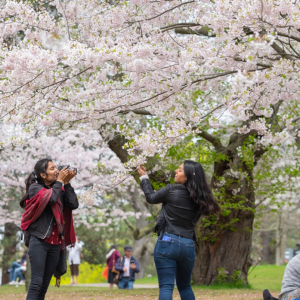Reducing Anxiety Through Nature
Sherry has taken her upbringing in rural Saskatchewan, together with a career in public health, to the “natural” conclusion that time in nature is good for us, physically, emotionally and socially.
Is “fight or flight” a friend or foe?
For millennia, the biological ‘fight or flight’ reaction has served to protect members of the animal kingdom from harm. It kicks in when there is potential danger; for example, when a rabbit senses a fox. There is an autonomic cascade of reactions that is activated in the amygdala in the brain. In turn, it signals the hypothalamus which launches a series of reactions of the sympathetic nervous system. Adrenaline floods the body causing increased heart rate and respiration. Glucose goes to the muscles for instant energy; senses are heightened to hear, see and smell danger. If the threat continues, additional hormones are released, including cortisol, to sustain the stress reaction for longer periods of time[i]. This physiological response enables the “fight”- the buffalo charges the wolf, the blue jay attacks the owl, the mother bear protects her cubs. In some species it enables the ‘flight’- the slap and swim of the beaver, the skittishness of songbirds, the sudden dive of a frog. Quick response to danger is vital to survival of the organism, and ultimately of the species.
The Human Experience
Humans also experience this biological phenomenon when we are stressed. Nowadays, the stress is seldom related to a predator’s attack, but we do experience a stress response to difficult life events as well as day to day challenges. We feel our heart pound, our breathing quicken, our muscles tense, our gut clench. This response helps us respond to emergencies and extract ourselves from uncomfortable situations. Mild stress can be positive; it heightens our senses, motivates us and improves performance.
But what happens when our body stays in a persistent stress response? We become overly anxious, worried, tense, tired and even depressed. We experience panic attacks without provocation. Chronic stress with elevated hormones is hard on our blood vessels and cardiovascular system; it increases the appetite leading to weight gain[ii]. If it reaches a level where it interferes with daily living it can become a clinical anxiety disorder: phobias, panic disorder, social anxiety disorder, generalized anxiety, post traumatic stress syndrome, obsessive-compulsive disorder[iii]. According to Statistics Canada 8.6% of Canadians have a diagnosed anxiety disorder[iv].
The Effects of Time In Nature
Time in nature can directly counteract some of the physiological and psychological effects of anxiety. Research is showing that for healthy individuals time in greenspace contributes to mental health; for those with diagnosed mental illness, including anxiety disorders, time in nature can be an effective component of treatment[v].
Spending time in, or even passively viewing, greenspace, has beneficial psychophysiological effects[vi] by lowering blood pressure, muscle tension, and heart rate. Cortisol is lower in people when they are in nature. The Attention Restoration effect reduces some of the mental fatigue of being in protracted fight or flight mode. Time in nature decreases rumination, which is the persistent recurrence of unwanted negative thoughts[vii]. The affiliated effects of time in nature, in particular increased physical activity and increased social connectedness, in and of themselves, are beneficial in reducing stress and anxiety[viii].
Getting nature in your day
With the hectic holiday period soon upon us, let all of us ensure that we build time in nature into our daily routines. Walk through the park on the way to work, watch the birds at the feeder for a few extra minutes, get out on the snowshoes in the woods. Use a natural scene as your computer screensaver, put up some photographs from your camping trip, get some plants or fresh cut flowers for the house, start a nature journal to record thoughts, observations, doodles and poetry.
There is some irony that nature where generations of humans experienced “fight or flight” is now our respite from stress. The natural world is balm for the senses; even in the winter, the smell of balsam, the fresh cold on the face, the sound of running water, the serenity of snow covered trees can help us de-stress and calm the anxious mind.
Wishing you all time in nature, and may it bring you peace and good health in 2019!
Sherry, RN BSN
[i] Harvard Medical School. Understanding the stress response. Downloaded on November 8, 2018 from https://www.health.harvard.edu/staying-healthy/understanding-the-stress-response
[ii] ibid
[iii] Canadian Mental Health Association. Anxiety Disorders. Downloaded November 9, 2018 from https://cmha.ca/documents/anxiety-disorders
[iv] Statistics Canada. 2017. Mental Health Disorders and Life Satisfaction in Canada. Downloaded on November 8, 2018 from https://www150.statcan.gc.ca/n1/pub/11-627-m/11-627-m2017033-eng.htm
[v] National Collaborating Centre for Environmental Health. 2015. Summary: Review of Green Space and Mental Health. Downloaded October 2016 from http://www.ncceh.ca/sites/default/files/Summary-Greenspace_Mental_Health_Mar_2015.pdf
[vi] Beyer, K. M. M., Kaltenbach, A., Szabo, A., Bogar, S., Nieto, F. J., & Malecki, K. M. (2014). Exposure to Neighborhood Green Space and Mental Health: Evidence from the Survey of the Health of Wisconsin . International Journal of Environmental Research and Public Health, 11(3), 3453–3472 Downloaded November 8, 2018 from https://www.mdpi.com/1660-4601/11/3/3453/htm
[vii] Bratman et al. 2015. Nature experience reduces rumination and subgenual prefrontal cortex activation. Downloaded May 3, 2018 from https://www.ncbi.nlm.nih.gov/pmc/articles/PMC4507237/#!po=8.62069
[viii] National Collaborating Centre for Environmental Health. 2015. Summary: Review of Green Space and Mental Health. Downloaded October 2016 from http://www.ncceh.ca/sites/default/files/Summary-Greenspace_Mental_Health_Mar_2015.pdf



